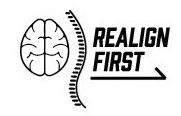 Naomi@RF
Naomi@RF
COVID-19拡大防止の対策について
この度は、Realign Firstに興味を持って頂きありがとうございます。
カナダ在住の皆様におかれましては、ご存知の通りCOVID-19が猛威を振るっており、平穏な生活が大幅に乱される事態となっています。社会の安全を守るため、Realign Firstではご来場によるパーソナルセッションを見合わせております。
しかし、社会的距離を守ったり、外出をできる限り自粛するとともに、個人個人でしっかりと健康を維持し、免疫力を上げておくことは忘れてはなりません。
そのためにはしっかりとした栄養、休養、そして適度な運動が必要です。
どのような運動をしたらいいか、何から始めたらよいか、不安な方がたくさんおられます。
自分のカラダ、そして健康を維持するために行う運動に少しでも自信を持ってもらいたく、この度、オンラインでのパーソナルサービスを開始しました。
ZOOM(ビデオチャット)で健康を維持する上での悩み、不安などを解消し、個々に会った解決策を提示、サポートさせてください。
ご予約はこちらのリンクより行えます。
calendly.com/gnkadvantage
ぜひご利用ください。
既存のお客様各位。
平素よりRealign Firstをご利用いただき誠にありがとうございます。
この度、リアラインのセッションを一時中断せざるを得ない状況になり、皆様にお会いできず、非常に心苦しい日々を送っております。
社会的義務を果たし、一刻も早いCOVID-19の消息を願うばかりですが、それまでの間、できる限りのサポートを継続させていただきたいと切に願っております。
サポートの内容はなんでも結構です。バーチャルの指導やワークアウトも可能です。ぜひ、繋がりましょう。
ご予約はこちらのリンクより行えます。
calendly.com/gnkadvantage
プリペイドの残高があるお客様は、特別なリンクをお送りいたしますので、一度お問い合わせください。
皆様と再会できる日が1日でも早く来るよう願っています。
Realign First代表
江口なおみ
How experts can help.
A message from Realign First in response to COVID-19
First, I would like to express my deepest condolences to those who lost their loved ones as a result of this pandemic, and gratitude to the dedicated frontline workers.
Hard times eventually pass. We all are forced to learn how a sudden change in norms affects us, and how to adapt.
One of the major adaptations is how to connect and stay connected with each other in times like this.
Although this is tough and may not be ideal, let's try to think of it as an opportunity to face uncertainties in a positive way (after all, isn't life all about uncertainties?), to challenge ourselves to step out of our comfort zone, learn new things, face things that we have put off for a while and grow.
This includes taking care of ourselves..
It can be a time to reorganize our values and priorities, so that once we overcome this worldwide, historic, challenge, we will have a clear direction.
In response to this paradigm shift, I would like to announce that Realign First will start offering more online services. Please read the section below, "Special Announcement," for details.
Realign First Owner,
Naomi Eguchi
Uploaded on March 28, 2020
Special Announcement
TIP 17: Introducing the “Inner Unit” unit.
Let’s jump right in.
Allow me to introduce the “behind the scene” superstars; the Diaphragm, the Transverse Abdominis, the Multifidus, and the Pelvic Floor muscles.
These are the 4 muscles (muscle groups) that create the
“internal abdominal pressure” in order to stabilize the core region.
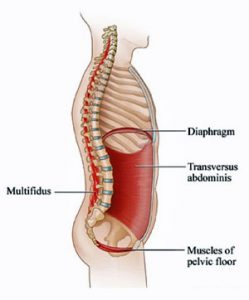
This picture shows you “where” these 4 muscles (muscle groups) are located.
Top→ Diaphragm
Bottom→
Pelvic Floor muscles
Front (side)→
Transverse Abdominis
Back→ Multifidus
When these muscles are able to contract (flex) together at the same time, well balanced “internal abdominal pressure” is created!
However,,,
derived from VARIOUS reasons, one or more of these muscles can be or become weaker than the other, which then can create an
“imbalance” in the “internal abdominal pressure”.
What happens when there’s imbalance?
It could mean increased stress or “leaks” of pressure in those weak areas.
ANYTHING and EVERYTHING, from low performance in sports to low back pain to incontinence to bad posture to shallow breathing,,, the list goes on and on.
I don’t know many people who have never experienced any of the above (especially after like 30 years of age).
Do you?
The fact that these symptoms (there are a ton more) are extremely popular, mean that we are not good at automatically knowing how to “keep” our inner unit strong (enough).
I’m not saying you should blindly start strengthening our inner unit, or we all need to aim for perfectly tuned & strong inner unit.
What I want you to know is, by working to create a better balanced “internal abdominal pressure”, we can “minimize” these symptoms.
Moreover, I want you to know that “minimizing” these symptoms, are in fact, a choice.
When I say it’s a choice, I mean there’s no excuse not to start strengthening these muscles.
NO gym required,
NO equipment required,
NO money required,
NO chunk of time required,
NO age limit,
just some knowledge, some will, and devotion.
Of course, if you are an athlete, or engage in high demand physical activity, you would need a strong inner unit relative to those demands.
TIP16: Strong “CORE” for Everyone.
Today, I am going to explain why a strong core is not only for those who wish to lift super heavy weights in the gym room or become a super athlete.
But, that’s not all.
First and foremost, you want the “CORE UNIT” to be working because the Spine is the only skeletal structure (bone) supporting the “CORE” region !!
 Imagine holding a huge cotton candy. What if the candy was as heavy as ice cream the same size?
Imagine holding a huge cotton candy. What if the candy was as heavy as ice cream the same size?
It would either be impossible to hold or feel extremely insecure. How would you resolve that situation? Wouldn’t you be more comfortable holding it with a thicker bar?
Same with the body. Stronger “CORE”, supports the spine.
What happens when the “CORE” is not strong enough?
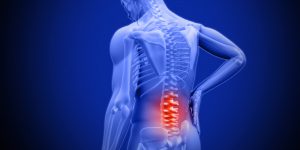
We develop back pain, usually around that “CORE” region where the spine alone cannot support the weight of our upper body.
Activating specific muscles in the “CORE” region will help you say goodbye to chronic back pain
What are these “specific muscles” ??
They are the “behind the scene” superstar unit called the “INNER UNIT” of the “CORE”.
Tomorrow I will reveal the actual muscles of the “INNER UNIT” and why they are oh so important.
TIP15: CORE 101-2
The first“CORE” tip I gave was that the “CORE” needs to be “STABLE” in order to functionally use our body/muscle systems.
Today I will show you WHY & HOW we create a stable “CORE”.
When we say “stable core” it really means creating enough pressure in our core region so our body (in this case, our spine) doesn’t break like a twig when we face a large external force. (This is the primary “WHY”)
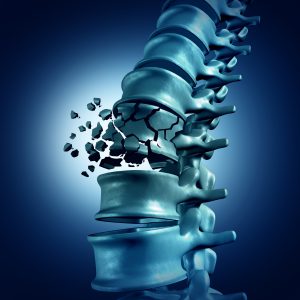
(Don’t worry, this doesn’t happen easily)
Have you seen weight lifters with a huge belt around their core when they squat with heavy weight???
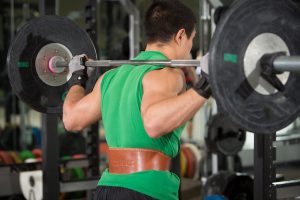
That belt, used to protect you from potential damage, assists you to create that pressure.
This is called, “internal abdominal pressure”
which is,,
EXACTLY the “CORE UNIT”s job!!!
That’s what the “CORE UNIT” does, it protects.
If the “CORE” muscles are working properly, that means the “core region” is stabilized (ready for high demand).
Now, you might think having a strong core is unnecessary for you because you may have no intention in squatting 200lbs.
I will prove you wrong tomorrow.
I will convince you why it is necessary for you to want your “CORE” to be working optimally.
TIP14: CORE 101-1
You’ve probably heard of the “CORE” and how “Important” the “CORE” is, and how we should “Strengthen” our“CORE”, and so on.
But what (where) is the “CORE”, exactly?
Again, the “CORE” is such an ambiguous term, the definition would slightly differ among health professionals.
These are just a few of the examples when I did a google search, “core, body”.
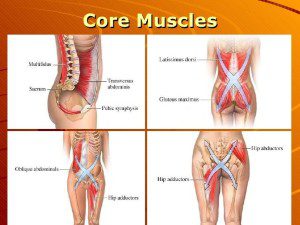
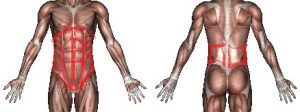
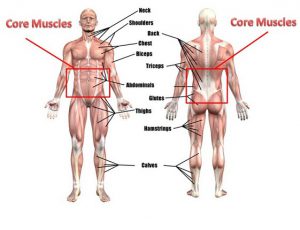
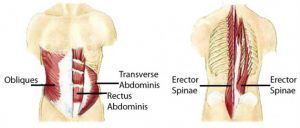
As you can see, everyone has their own way of describing the “CORE”.
As much as it is nice to be able to see it visually, you might be left confused if you encounter more than one of these images.
So, what is the“CORE”?
What should YOU know about the“CORE”?
Would knowing which specific muscles compose the“CORE” make you strong? Maybe? Maybe not?
You already know the “CORE” is important so you know you want to strengthen it, right?
If so,
wouldn’t you want to know the reasoning behind why the “CORE” should be strong?
If you know the “why” you would easily understand “where” and “what” to focus on when trying to build a strong “CORE”.
I’ll tell you the “why” today.
Our body has sets of muscles that work together.
These “sets” of muscles are what a simple movement like walking to a complex movement like throwing or swimming.
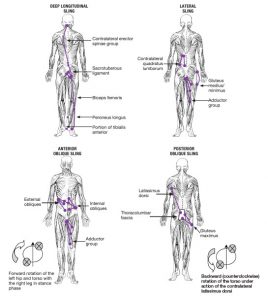
This may be referred to as “Functional” movements.
These systems of muscles working together allow us to do many movements without commanding each muscle to move. (that would be super hard)
However, in order to ignite the power of these muscles systems properly, the “CORE” MUST STAY STABLE.
You can see the purple line in the above transfers through the central part of the body. If that central part is unstable, power cannot transmit through.
In other words, my definition of the “CORE” is the group of muscles that get’s your body ready to exert optimal strength & power.
Strength comes from big muscles in our body, but without a strong enough core engagement, we can’t switch our well-engineered muscles systems on the way we hope to.
Is your “CORE” stable?
TIP13: Good Posture.
What do you imagine when you think of “Good Posture”?
You may think of a particular person, a healthy looking individual, or some imaginary being.
Now, how would you explain what “Good Posture” is??
The answer to this is that there is no one definition of
“Good Posture”.
What people think as “Good Posture” can change over time, and also can be influenced by cultural expectations.
Even health professionals change their version of the definition of “Good Posture” all the time (as they become more knowledgeable).
I’m not writing this to make you confused.
I’m writing this because I want you to start to “feel” things rather than trying to imitate what you see or what people have told you.
“Good posture” in my sense is when you feel the most “Natural”.
When you feel “right”, or “comfortable”.
When you don’t feel any muscles working harder than others.
You need to know how to create this situation with your own body.
 These are all examples of imbalanced muscle use.
These are all examples of imbalanced muscle use.
The red areas are the overused muscles associated with the indicated posture.
Which of your muscles generally tend to get tight?
Now, let’s try to recreate a “Natural Posture”.
HINT1: Start by imagining where your center of gravity is.
You can figure that out by imagining how heavy each body part may be.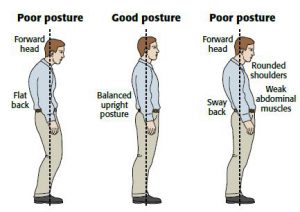
HINT2: The further you move away from the center of the earth, heavy objects become more unstable if they are “off-centered”.
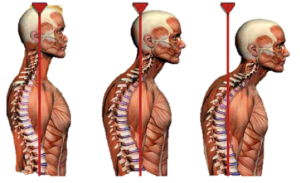
Can you apply these ideas to your body in order to create
“Good Posture”? I think so.
Play around with leaning in one direction, or lifting your arm, moving you head positions to change the center of gravity of your body.
Feel.
Feel where tension may increase and decrease.
Having trouble finding the sweet spot?
Always get stuck fitting the last piece of the puzzle??
That is YOUR unique area you need to work on.
TIP12: Pelvis 201 The Pelvic Tilt
Before we jump in what the “Pelvic Tilt” is,,,
Please note that what I want you to get out of today’s tip is what the “consequences” of these tilted positions (for a prolonged time) are.
You might already know what a “Pelvic Tilt” is, or mean, but the significance of it and how it affects the whole body continues to be a hot topic among health/ fitness professionals.
Below is is a side view of a super simplified description what a “Pelvic Tilt” looks like.
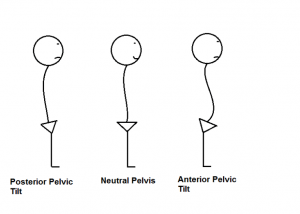
Left: Posterior Pelvic Tilt
Centre: Neutral Pelvis
Right: Anterior Pelvic Tilt
You can see, how the angle of the Pelvis, influences the curvature of the spine. (Consequence 1)
Usually, we all have a tendency to fall into either anterior or posterior tilt.
Now, imagine yourself in countryside Africa, having to carry a load on top of your head.
 You might have never tried this, but you can imagine.
You might have never tried this, but you can imagine.
Now, go back to the first image and think which pelvic angle you would want to have in this situation.
Which angle looks suitable and the least damaging??
Now, we are fortunate enough to live in a world where we rarely encounter this type of situation, but we still need to keep in mind our “head” is as heavy as a “bowling ball”.
You need to know the BIG advantage of maintaining a neutral pelvis for your postural health and vice versa.
The more you spend time in a tilted pelvic position, the more your core muscles become weaker to maintain neutral pelvis poison and the more you will face issues along the spine (low back, mid back, upper back, and neck,,,, sound familiar??) (Consequence2)
In addition, your posture-related muscles adapt to whatever posture you are in the most, creating many muscular imbalances throughout the body. (Consequence3)

This is no exception with sitting.
 You may say “it is so hard to maintain a good sitting posture for long “.
You may say “it is so hard to maintain a good sitting posture for long “.
You are absolutely right. Us humans weren’t designed to sit for prolonged periods of time, of course, it’s difficult!!
What you can start from today is to start observing yourself.
This first step is to become aware how much time you may be spending in a tilted pelvic poison.
